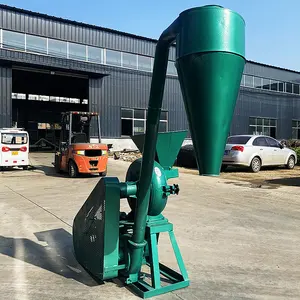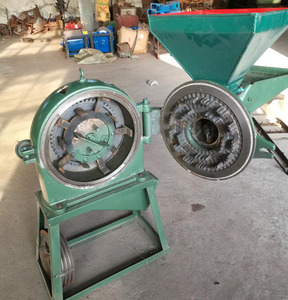(12213 products available)





























































































































































































































A small corn grinder can be divided into two main types of structures based on how it processes corn kernels: the disk mill and the hammer mill.
A disc mill is a piece of machinery that grinds materials by cutting and crushing them. The corn grinder consists of two horizontal steel plates with vertical projections arranged in concentric circles. The corn is fed into the grinder through the center of the discs and is then crushed and milled between them. The grinding disc is made of high-carbon steel. The plates are also made of cast iron, but they are usually lined with bronze or brass. This is because the plates need to be strong to withstand the pressure from the corn when it is milled. The vertical projections on the disc also help to break the corn into smaller particles by cutting and shearing it. A disc mill can be used to grind a wide variety of materials, such as corn, wheat, and rice.
A hammer mill is a piece of equipment that is used to crush or shred materials into smaller pieces. The way it works is simple. The material to be processed is fed into the machine from the top and then hammered and crushed by a series of hammers that rotate at high speeds within a steel drum or casing. The hammers are free to swing on the ends of the cross and fixed to the central rotor. Some variants of hammer mills have a screen that covers the discharge opening to control the finished particle size. Hammer mills can be used to process various materials, including grains like corn, wheat, and sorghum. They are also used in the production of food for animals and industrial ethanol.
There are other types of corn grinders besides the two main types. The two main types of corn grinders can be classified into electric and hand-operated. Electric corn grinders are more efficient and faster than hand-operated grinders.
When it comes to the specifications of a small corn grinder, it's important to note that the details may vary depending on the specific model. Nonetheless, here are some common specifications to look out for.
Maintaining a small corn grinder properly is essential to keep it in top working condition. Here are some helpful tips for maintaining a small corn grinder.
Small corn grinders are versatile machines used in various industries and applications where corn needs to be ground into more refined products. Here are some common usage scenarios:
In the food processing industry, small corn grinders are used to make a variety of food products. The grinders can process corn into cornmeal, which is a critical ingredient in the production of tortilla chips, tacos, and other corn-based foods. The grinders can also be used to make cornflour, a popular ingredient in baking, and to make refined cornstarch used in thickening agents in cooking.
In the agriculture industry, small corn grinders are used for grinding whole corn kernels into animal feed. The grinders can be used to make poultry feed, cattle feed, pig feed, and other animal feeds. The grinders help to process the corn into more palatable and digestible forms that are used to feed livestock.
In the hospitality industry, small corn grinders can be used in cafes, bakeries, and restaurants to make fresh corn-based products. The grinders can be used to make corn flour, which can be used to make cornbread, pancakes, and other products. The grinders can also be used in restaurants to make corn tortillas from scratch. Grinding fresh corn enhances the flavor and nutritional value of the final product.
Small electric corn grinders are also commonly used in homes to grind corn into different food products. Homeowners with small corn grinders can use them to make fresh corn flour, which can be used to make homemade tortillas, muffins, pancakes, and other products. Some people also use the grinders to make cornmeal, which can be used as a healthy alternative to all-purpose flour in baking.
Small corn grinders are also used in the brewing industry to crack open grains such as corn and barley. The grinders help to break the grains into smaller pieces, which are then used to make beer, whiskey, and other alcoholic beverages. The grinders ensure that the grains are properly processed, which enhances the flavor and quality of the final product.
When purchasing a small corn mill for sale, a buyer should focus on matching the overall capacity of the equipment with the intended production. The corn grinder should be able to grind the desired amount of corn within the required time. Buyers should also look for grinders that can process different corn varieties to meet customer demands. If a buyer is unsure of what to buy, they should consult with a supplier to find a suitable machine. The corn grinder should be easy to operate and maintain to reduce downtime during the production process. Additionally, it would be useful to source a corn grinder that includes a manual or offers technical support.
When choosing a corn grinder, it's essential to consider the desired corn flour quality. If the buyer wants to achieve fine corn flour, they should go for a grinder with a fine-tuning feature. If the buyer is unsure, they can request samples of flour produced by the grinder before making a purchase.
When choosing a supplier, it's essential to find one with a good reputation. The supplier should have positive reviews from previous customers, and their equipment should be reliable. Inquire if the supplier offers after-sale support to assist in case of any problems. If possible, get recommendations or read reviews about the supplier before making a purchase. The supplier should also offer competitive prices and discounts for bulk purchases to help the buyer save on costs. It also helps to compare prices from different suppliers to find one that meets the budget requirements. The supplier should also have different types of corn grinders to choose from. If the supplier has a limited selection, they can help the buyer find a suitable machine that meets their needs.
Q1 What is the difference between a small corn grinder and other food grinders?
Unlike other food grinders, small corn grinders are uniquely designed to deal with corn. This means that their construction, blades, and other components are well suited to the task of grinding corn. These grinders also differ from other grinders because they have a built-in separation mechanism that separates the outer parts of the corn from the inner parts as it grinds.
Q2 What is the difference between a hammer corn grinder and a burr corn grinder?
Hammer corn grinders use plates with free-swinging hammers to grind the corn, while burr grinders use two grinding plates that rub against each other. Hammer grinders are more versatile because they can grind both wet and dry material. They are also faster and can handle large volumes. Burr grinders are more effective at producing uniformly fine ground corn and are more efficient than hammer grinders when it comes to energy use.
Q3 What is the difference between manual and electric small corn grinders?
Manual corn grinders are operated by hands, while electric corn grinders are powered by electricity. Electric corn grinders are faster and more convenient to use than manual grinders. While electric grinders are more efficient, they are also more expensive and require a power source. Some people prefer manual grinders because they can be used in off-the-grid locations.